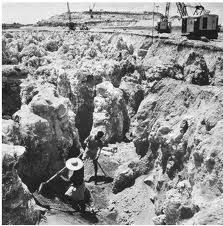
IDLE NO MORE: Phosphate Mining in the Pacific Island of Nauru
The Most Outrageous Example of the Exploitation of an Environment and A Culture
As our poorly educated Republican Legislature led by our college drop-out Governor continues to “carry water” for the out-of-state mining interests and plan to destroy the environment in Northern Wisconsin while ignoring the treaty rights and cultural interests of the indigenous people of the region, it is appropriate to look at other tragedies of exploitation.
One of the many tragedies of colonial extraction economies is the Pacific Island of Nauru which was depleted of all of it's Phosphate during the latter part of the 20th Century. In her 2005 Paper “Nauru: An Environment Destroyed and International Law” Mary Nazzal describes Nauru of the past and Nauru in the present, after the Phosphate mining was completed. The following are her words.
Paradise Island Transformed
“Nauru was once an idyllic palm-encrusted isle overflowing with lush greenery,
coconuts, tropical fruits, flowers, birds, all enveloped by coral reefs teeming with
underwater life. As the smallest nation in the world, Nauru’s landmass is shaped like an
inverted saucer with a circumference of under twenty kilometres. Located just south of
the equator and halfway between Hawaii and Australia, Nauru is particularly remote.5
The absence of nearby islands coupled with the strong westerly flowing equatorial
current prevented the Nauruans from exploratory travel and limited them to their island.
Fortunately, they could satiate themselves with fish as well as mangos, breadfruit, and
pineapples, which grew on the Buada Lagoon southwest of the island. The coastal belt
flourished with coconuts, pandanus, and wild almond trees while hibiscus coloured the
island’s central plateau. Isolated from the outside world, the Nauruans conversed in their
own language and developed a self-contained, durable society. In the words of biologist,
Carl N. McDaniel, “Year in and year out they lived intimately connected to the other
inhabitants, real and imagined, that shared their world of palm trees, noddy birds, sand,
sea, and sky.”6 Indeed, Nauru’s breathtaking beauty led an English whaler to name it
“Pleasant Island” in 1898. Unlike other Pacific Islands however, Nauru was remote,
small and lacked the treasures of the time, such as pearls or tortoiseshell and was thus
largely ignored by Western explorers. For time immemorial, Nauruans were left alone to
fill their days with singing, dancing, storytelling, string figures, and other traditional
activities.7
The Nauruan lifestyle began to transform as colonial powers assumed power
over vast areas of the world. The need for raw materials and new markets fuelled an
expansionist agenda and was to forever change the lives of most all indigenous peoples,
such as the Nauruans. In 1886, England and Germany reached an agreement
establishing each country’s dominion in the Western Pacific.”
Phosphate and Environmental Damage
“Nauru’s insides were literally ripped out by extensive mining due to the fact that
phosphate mining is notably destructive. Mined land is transformed into coral-limestone
pinnacles and Nauru today is mostly dusty arid barren wasteland. This terrain is clearly
uninhabitable and the resulting pillar and pit landscape combined with the loss of
vegetation has created a very hot interior. This rising hot air has prevented rain clouds
from settling over the island contributing to frequent droughts. Plus, the natural forest
microclimates have been transformed into new microclimates increasing sunlight and
lowering humidity. As Weeramantry points out, scientists have always been attracted to
the uniqueness of the Pacific Islands and they have observed “the disastrous effects and
almost total disruption of island ecosystems that resulted from inappropriate
development projects and land use,” such as widespread phosphate mining.22 All of
these changes have served to greatly alter patterns of vegetation and endanger a
number of indigenous plant species. The Nauruan diet was immediately affected by such
drastic changes in vegetation. Under the impact of the phosphate industry, fish and
coconut that were once staples of the Nauruan diet were largely replaced by salty and
fatty canned foods. It is undeniably clear that alongside the forceful erosion of the land,
the Nauruan way of life and intricate relationship with their surroundings was also
eroded. An integral element in the Nauruan lifestyle was its complete dependence on the
tiny island. The islanders used the island for both their livelihood and their enjoyment.
Indeed, the Nauruan circle of life was profoundly affected by phosphate mining as
illustrated by the words of a Nauruan song; “All our lands on the hill..No longer can be
used..Will become home of craters and rocks (sic).”23
The implications of environmental degradation for Nauru as well as for the rest of
the world are multi-faceted and often not obvious in the short-term. Harmful
environmental conduct exposes several broader dimensions such as the nation’s ability
to use its resources as determined by domestic political processes. The depletion of
phosphate has undoubtedly limited the political and economic choices available to the
Nauruans since they bear the direct brunt of dealing with seemingly irreparable
environmental damage. The adverse effects of environmental damage on the health and
future well-being of the Nauruans has likewise become tragically clear. For instance, the
problem of land shortage due to mining is one of the many pressing social problems in
Nauru today. Several of these problems can be traced back to colonial practices on the
island and were thus highlighted in the case presented to the International Court of
Justice.”
Paradise of Northern Wisconsin Transformed
Let the tragedy of Nauru be a message to all of Wisconsin.
